Feral facts and fallacies
Synopsis : Are feral colonies recently lost swarms or a self-sustaining ‘wild’ honey bee population? The latter must reproduce faster than they perish. Measuring rates of colony loss and nest occupancy provides a good indicator of the likely origin and independence of feral populations.
Introduction
Most colonies try to swarm every year. Most – not all – but if your colonies are strong and healthy they are likely to swarm. That’s why swarm prevention and subsequent swarm control are such important skills for the tyro beekeeper to master. Without swarm control the majority of the workforce is ‘lost’, the residual colony will be left temporarily queenless and the potential honey crop is probably much reduced.
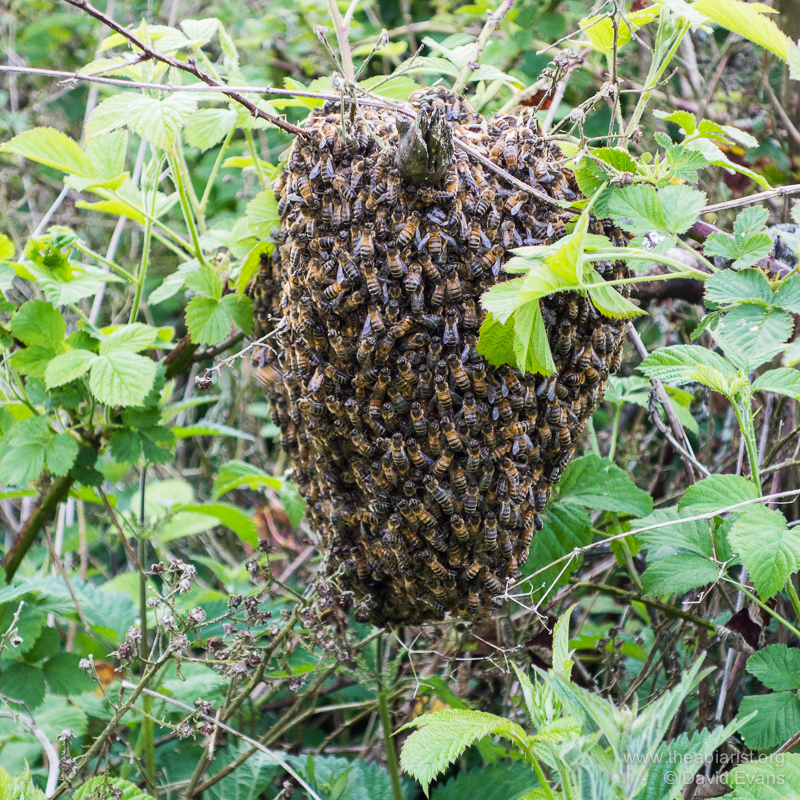
A small swarm …
It is not difficult to become competent at swarm prevention and control. However, any beekeeper who claims to never lose swarms is probably being ‘economical with the actualité’ as the late Alan Clark once said.
What happens to those ‘lost’ swarms?
Some forward-thinking beekeepers set out bait hives. Any swarms that end up being attracted to these ‘swarm traps’ will eventually find their way back to a managed apiary. Some swarms end up in the church tower where ‘there have always been bees’, according to local parishioners.
Others move into the roof space above the entrance to the local nursery school, causing fascination, irritation and consternation in equal measure. Their fate depends upon whether the head teacher contacts a beekeeper or a pest controller … but their arrival reinforces the importance of swarm control and the use of bait hives.
And other swarms disappear over the apiary fence, across the field and into the local woods, eventually establishing a new colony in a suitable hollow tree.
No risk, no reward
Swarming is a risky business. The swarm leaves with the majority of the flying bees and the mated queen. However, it takes more than that to establish a functional colony. They need to draw comb, rear brood and collect sufficient stores to get through the winter.
That’s a tall order and most swarms fail.
Data from Thomas Seeley in The Lives of Bees suggests that only about 23% of swarms survive the winter.
In contrast, the swarmed colony has about an 80% chance of survival. They’ve got drawn comb, stores, eggs and larvae … ‘all’ they need to do is rear a new queen.
And then they’re likely to swarm again the following year {{1}}. In fact, without swarm control, the average number of swarms produced by a colony is two per year – presumably a prime swarm (headed by the old queen) and a cast (headed by a virgin queen).
So, swarming is risky, but those swarms that succeed in establishing a new colony and overwintering can themselves attempt to reproduce again the following year.
That’s the reward.
Where are all these bees?
Even taking account of the exemplary swarm control by the UK’s ~25,000 beekeepers {{2}} I’m reasonably certain that a lot of swarms are lost every year.
Where do all these bees go?
I’ve been told of lots of churches or schools or trees with resident bees.
However, it’s certainly not every church, or school or hollow tree that’s occupied. Even when there’s a surplus of suitable nest sites, those that are occupied by a colony are the exception, not the rule.
The main reason of course is Varroa.
In the absence of intervention to reduce the mite population, the developing winter bees get parasitised by Varroa, and the resulting high levels of deformed wing virus (DWV) reduces the longevity of these necessarily {{3}} long-lived bees.
Consequently the winter cluster shrinks in size, from that of a football (early October) to a honeydew melon (late December) to a large orange (early February).
And then it freezes to death during a cold snap 🙁 .
Numerous studies have shown that untreated colonies, in the absence of any natural resistance or tolerance to Varroa or DWV (though the latter is rarely discussed, and even less frequently tested for), almost always perish within a year or two of Varroa infestation.
Look back at the recent post on Biological control with Varroa for a reminder of the devastation wreaked on an island population of honey bees after the introduction of mites.
Wild? They’re livid feral …
Technically, swarms lost by beekeepers (that become established in the environment) are probably best termed feral colonies.
Originally feral meant simply ‘wild or untamed’, but the more common usage these days means ’animals or plants that have lapsed into a wild form from a domesticated condition’.
Bees aren’t domesticated, but I think feral conveniently encompasses their origin.
However, I’m more than happy to accept that a colony, initially feral, that becomes well-established in the church tower and throws off a swarm or two every year, that requeens every two or three seasons, surviving without intervention or management, must be considered ‘wild’ at some point.
It’s not worth discussing when a colony transitions from feral to wild.
It’s semantics, though I think the distinction between ‘recently arrived from a swarmed managed colony’ and ‘self-sustaining’ is an important one.
Notwithstanding the ravages of Varroa, whether feral or wild, there are colonies in the environment – churches, schools, trees – and probably rather more than many beekeepers are aware of.
The missing bees
Periodically there’s a little flurry of interest in the press about ‘long lost’ or ‘missing’ wild bees discovered in the woods.
Late last summer there were articles in all the newspapers about bees found on Blenheim Estate. The Observer reported this discovery with the headline ”No one knew they existed”: wild heirs of lost British honeybee found at Blenheim.
As an aside – as this isn’t the real topic for discussion today – there are at least three challenging claims made in that headline; how can you be sure that no-one knew they existed? Is the British honey bee (it is not honeybee) actually lost? How do you know that these bees are their heirs?
Pedantic is my middle name.
But the 2500 hectare Blenheim Estate {{4}} isn’t the only location with apparently self-sustaining populations of honey bees. There are trees, churches and (I dare say) even nursery schools up and down the country that appear to have a ‘resident’ colony or two of bees.
Periodically they’re observed swarming. Sometimes things seem a bit quiet in the spring, but perhaps it’s too cold for the bees to be flying strongly anyway.
By May there’s a lot of activity so all must be well.
Right?
Perhaps 😉
Citizen science
These wild/feral colonies are infrequent but widely distributed. They are therefore difficult for one person to regularly observe. As a consequence there are several ‘citizen science’ projects monitoring some of these sites. Magnus Peterson regularly reports in The Scottish Beekeeper on the one he coordinates for the University of Strathclyde.
The criticism of these types of studies – certainly not Magnus’s specifically – but any study the largely relies upon infrequent observation by volunteers, is that stuff gets missed. A visit doesn’t happen because it’s raining hard. Or it does happen in heavy rain and no activity is observed and the colony is recorded as dead.
Or worse, recorded as alive, but not flying because of the heavy rain.
With more systematic observation, though not necessarily more frequent, you can have increased certainty that the site that was occupied last autumn is still occupied this spring.
The timing of these observations is important. Three per season is probably the minimum, early, mid and late, but they have to be at particular times of the season – see below.
Crowdfunding
So, let’s assume a colony is found in the autumn and the same hollow tree is occupied in late-April the following year … yippee, the colony is still alive.
Feral – or are they now wild? – bees living successfully with Varroa (at least presumably living with Varroa if they’re almost anywhere in mainland UK).
Perhaps they’ve evolved to have some interesting and useful trait(s) that renders the colony resistant to or tolerant of the dreaded parasitic mites?
These are valuable bees.
They are an important genetic resource.
They must be protected at all costs.
Perhaps it’s time to set up a web colony cam to record their activity? That’s going to cost a pretty penny, so some crowdfunding is needed.
A website is created … a dozen mini-nucs are purchased for the ambitiously planned queen rearing programme and – inevitably – there’s a misquoted article or two in the Guardian.
But hold on …
Are they really the same colony in April that were there the previous autumn?
How can you be sure?
How can you be certain that it’s not an unseasonably early swarm that was missed by the – usually eagle-eyed – local beekeepers? {{5}}
It’s not unusual to find the odd charged queen cell during the first colony inspection of the season. At least, I’ve sometimes found queen cells during that first inspection. I’m sufficiently experienced to not go rummaging about in the boxes too early in the season, and so I am sometimes surprised at how well developed the colony is when I open the box.
But what if it had been raining, so I’d postponed the inspection?
On the next warm spring day – well before I was able to return to the apiary – the colony could swarm.
I’ve regularly seen April swarms in Scotland and there are many reports of even earlier swarms on social media every year.
Perhaps the active ‘overwintered’ colony is nothing of the sort.
Maybe it’s just been occupied by a very early swarm?
To be sure it’s the same colony you need to do some genetic testing. If the colony is the same the genetic testing will show identity. If the testing shows significant variation then it’s a different colony.
And, if you combine some genetic testing of overwintered colonies with three carefully-timed visits – late season, very early season and mid-season – to a large number of wild/feral colonies, or likely sites that they would occupy, you can determine their longevity and whether they are a self-sustaining population.
Bee trees
And I wouldn’t have given that long and rambling introduction if there wasn’t a recent scientific paper where they’ve done exactly that (Kohl et al., 2022). I’ll describe it briefly as it’s a nicely written and compelling story. The paper is open access, so you can read it if you want to check my interpretation of the data.
Importantly, I think it provides a very good guide to both the quality and quantity of data that are needed to be sure a population of bees are truly wild and self-sustaining {{6}} … or just regularly boosted by careless local beekeeping!
Feral colonies are few and far between. It’s hard work walking around the woods looking for hollow trees that may (but probably won’t) contain a colony. You find lots of trees with holes, but they need to lead to a suitably-sized cavity to be of any use to a colony of bees. Binoculars help (the holes are often 15 metres off the ground) … but perhaps there are better ways of doing this?
Bee-lining – as described by Seeley in Following the Wild Bees – is an effective way of tracking down wild colonies, but needs good weather, good forage and ample time. It works well when locating a few colonies, but probably takes too long if you want 100+ to produce a statistically compelling set of results.
But what if you also wanted to record how many new nest sites are occupied? You would need to know where the empty cavities were before they were occupied. That’s not something you can determine by bee-lining, so you’re back to traipsing around the woods with a pair of binoculars.
Woodpeckers
But in Germany they have some very large woodpeckers.
The black woodpecker (Dryocopus martius) is a crow-sized bird that excavates correspondingly large holes for nest sites in old-growth forests. The average volume of a black woodpecker nest is about 10 litres, smaller than optimal for a swarm, but appreciably larger than most ‘natural’ tree cavities.
Conveniently, there are high-resolution maps of (historical) woodpecker nesting trees in old-growth forests in Swabian Alb, Weilheim-Schongau and the counties of Coburg and Lichtenfels. 98% of these woodpecker nest sites are in large beech trees, most are 10-12 metres above ground and with an entrance of ~10cm diameter (again, not optimal, but better than no nest site for a swarm).
Kohl and colleagues surveyed about 460 of these ‘cavity’ trees three times per season; in July (after the main May/June swarming season) to determine peak occupancy rates, in mid/late September to determine late summer survival and in early/mid April to determine winter survival.
‘Occupancy’ was determined by visual inspection and regular forager activity and/or pollen loads (i.e. they ignored scout bees checking empty cavities). In addition, for some colonies, a dozen or so workers were collected for genetic analysis.
With these data, the mathematical calculation of annual survival rates could be determined, as could the prediction of the annual numbers of swarms needed per colony for the population to be self-sustaining {{7}}. In addition, it was possible to determine the average lifespan of a colony.
There were a bunch of perfectly reasonable assumptions made, based upon the known biology of honey bees – all are listed in the paper.
Yo-yoing colony numbers
The scientists counted colony numbers, but could also determine colony densities per km2. By making observations over a 3-4 year period it was strikingly obvious that the largest number of ‘cavity’ trees were occupied after swarming in summer, but that numbers dropped dramatically overwinter. This ’recurring temporal pattern of population fluctuations’ is very obvious in the major data figure in the paper.
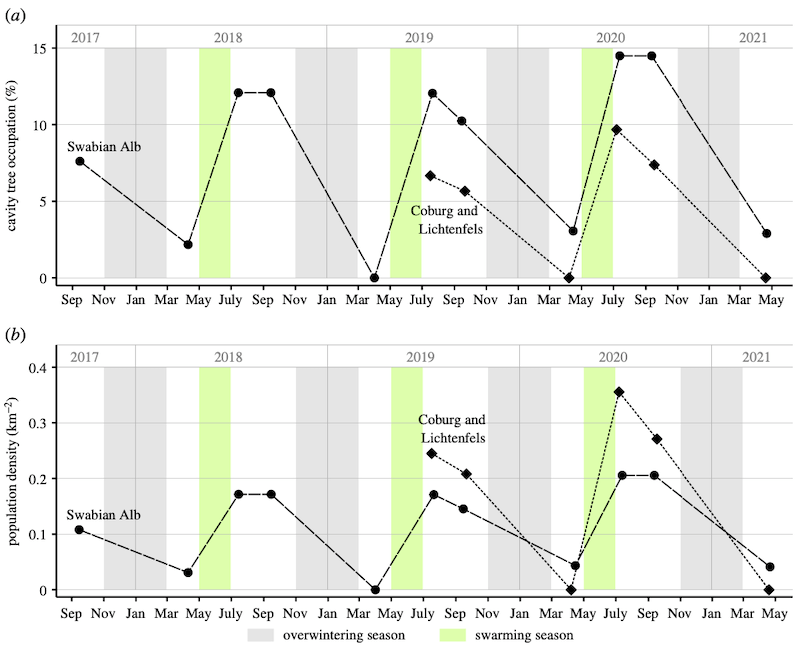
Temporal population fluctuations of feral honey bee colonies in Germany; A) occupancy rates, B) population density
The average maximum occupancy rate and population density was 11% and 0.23 colonies per km2. This ‘dropped massively’ over the winter to just 1.4% and 0.02 colonies per km2.
The majority of nest sites (n = 112) occupied in late summer were unoccupied the following spring, before swarming started. 90% of colonies survived the summer (from July until late September), but only 16% of colonies survived the following winter.
The spring survival rate was calculated as 74% based upon genetic testing of colonies in early spring and mid-summer
Knowing the summer, winter and spring survival rates enables the annual survival rate to be calculated.
This was a sobering 10.6%.
Therefore, to maintain a stable population, each surviving colony would need to produce an average of 8.4 swarms per season.
That’s an unachievable amount of swarming.
The average lifespan of a feral colony in these three German forest regions was just 0.619 years … a little over 32 weeks.
Clearly, these honey bee populations are not self-sustaining.
Are these German forests typical?
There are two other regions where similar quality data exists for wild/feral honey bee populations. These are the Arnot forest in the USA, studied for decades by Thomas Seeley, and Wyperfield National Park in Australia.
There are striking differences between these two regions and the German forests, both in terms of colony lifespan and swarm numbers needed to be self-sustaining.
For the Arnot forest and Wyperfield National Park, lifespan was calculated as 1.34 and 1.53 years respectively (cf. 0.62 years for Germany), with annual survival of ~50% (cf. 11% in Germany). Annual swarm numbers per colony for the population to be self-sustaining was 0.94 and 0.85 for the the Arnot forest and Wyperfield National Park respectively (cf. 8.43 for the German forests).
Other than these obvious differences in the related figures for survival/longevity and ‘swarms needed’ the other significant difference between self-sustaining populations (like the Arnot forest and Wyperfield National Park) is the colony density.
In areas where feral/wild honey bees are self-sustaining the colony density is at least 1 per km2. In contrast, in Germany and a large number of other studied feral populations in other parts of Europe (including Ireland, Spain, Serbia, Poland and other regions of Germany), the colony density is usually much lower, at 0.1-0.2 per km2.
So, these German forests are seemingly typical of honey bee populations that are not self-sustaining. These are regions where the feral population is boosted annually (and is essentially dependent upon) an influx of swarms that become temporarily established in natural nest sites.
Environmental colony density
Where do all these swarms come from?
The average managed honey bee colony density in the areas of Germany studied is 4 per km2, appreciably higher than either the Arnot forest or Wyperfield National Park. Precise figures for these two were not quoted, but in both locations the feral colonies (remember, these were at ~1 per km2) outnumber managed colonies.
It therefore seems very likely that managed colonies from farmland areas surrounding the German forests acts as the source for swarms, and the latter – because of the paucity of suitable nest sites in the arable land (relatively few buildings, few mature trees etc.) – gravitate towards the forests looking for suitable nest sites.
Feral and managed colonies may therefore be spatially separated, though not very widely. In contrast, in urban environments – where nest sites are probably common – it might be expected that feral and managed colonies are intermixed in the environment.
A by-product of the study by Kohl and colleagues is that they could also calculate the difference in the relative attractiveness of woodpecker nests that had previously, or had never, been occupied by bees. When new colonies occupied woodpecker nest sites there was a strong preference of 5 to 15-fold for sites that had previously been occupied by bees.
This, of course, is why it makes sense to include a single old, dark comb in your bait hives.
That seems like a good place to stop …
I think this German study is interesting. It shows the quantity and quality of data needed to make a compelling case that a location has a self-sustaining population of feral/wild honey bees.
Such locations are likely to exhibit colony densities of at least 1 per km2 and to be physically separated from higher density managed colonies. This physical separation could be in the form of simple geographic isolation – just a long way from other apiaries – or something more complex like being surrounded by high hills or water etc.
Self-sustaining wild/feral populations are likely to exhibit >50% annual survival rates, to live for an average of ~1.5 years and to produce about 0.8-0.9 swarms per colony per year {{8}}.
If survival rates are lower, or the life expectancy of a colony is much less, then the number of swarms needed to maintain the population rapidly becomes so high that they are unattainable.
In which case, large numbers of feral/wild colonies cannot be self-sustaining, but instead must be present because the area acts as a ‘sink’ for lost swarms from nearby managed colonies.
This post is already longer than my self-imposed-but-regularly-exceeded 3000 word limit so I’ll save further discussion of the Blenheim bees and other feral colonies for another post.
However, I hope the study shows that a healthy scepticism is perhaps sensible when considering any claims made about self-sustaining feral colonies.
That church tower in which ‘there have always been bees’ may well have had bees in it every year.
But that’s not the same as having the same bees in it.
In fact, with an ~90% attrition rate of feral colonies annually it’s very unlikely to be the same colony in successive years.
Note
In the final stages of completing this post – very, very late at night – I re-discovered an article (Moro et al., 2018) on citizen science and feral colonies that I’ll return to sometime in the future.
References
Kohl, P.L., Rutschmann, B. and Steffan-Dewenter, I. (2022) ‘Population demography of feral honeybee colonies in central European forests’, Royal Society Open Science, 9(8), p. 220565. Available at: https://doi.org/10.1098/rsos.220565.
Moro, A. et al. (2021) ‘Using Citizen Science to Scout Honey Bee Colonies That Naturally Survive Varroa destructor Infestations’, Insects, 12(6), p. 536. Available at: https://doi.org/10.3390/insects12060536.
{{1}}: Seeley’s data suggests that 87% of colonies swarm each year.
{{2}}: Was I smiling when I typed that? You’ll never know.
{{3}}: Because there’s little brood rearing in winter.
{{4}}: Variously reported also at 400 acres … I’ve gone with the larger figure for mathematical convenience next week as the numbers get downright weird – 50 colonies in 400 acres – if the smaller area only is considered.
{{5}}: What proportion of beekeepers can confidently tell whether their colony has or has not swarmed? Answers on a postcard …
{{6}}: They cannot be wild unless they are self-sustaining.
{{7}}: The maths is in the paper and very straightforward, but will put most readers off … so I’ll omit it from here.
{{8}}: These, not colony density, are the defining features of self-sustaining populations.
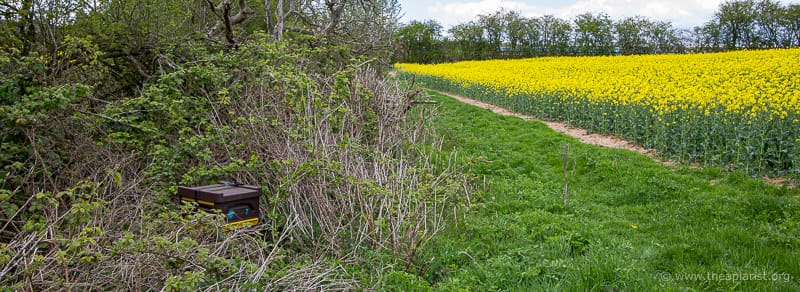

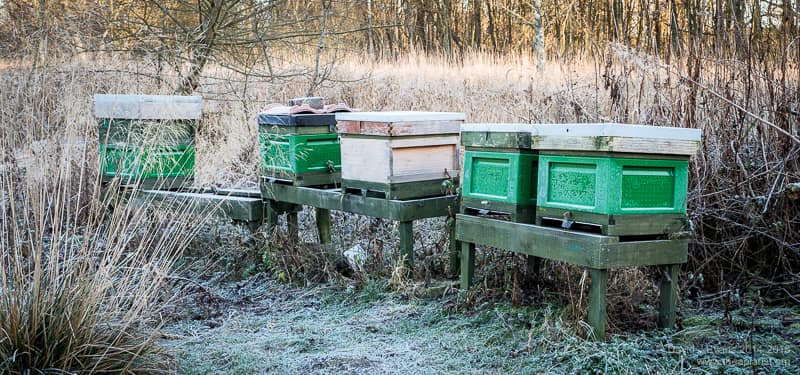
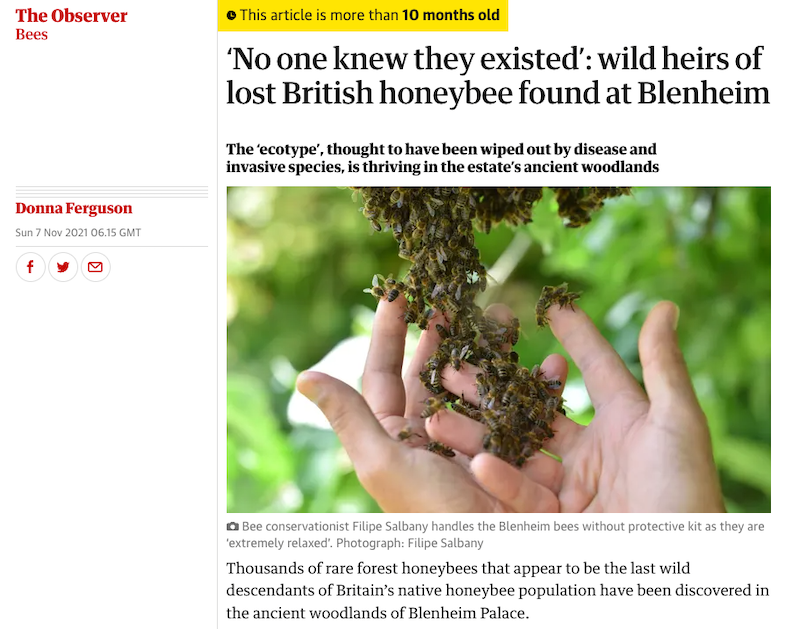
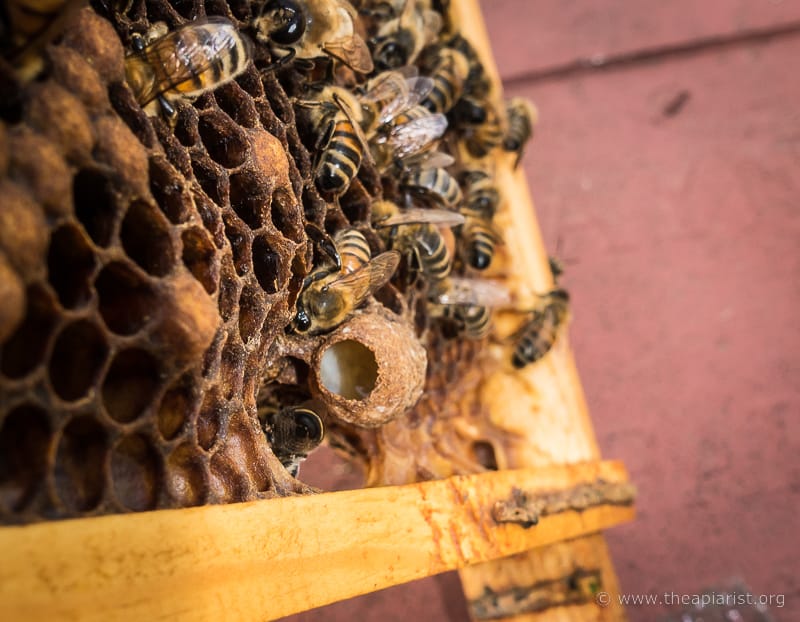
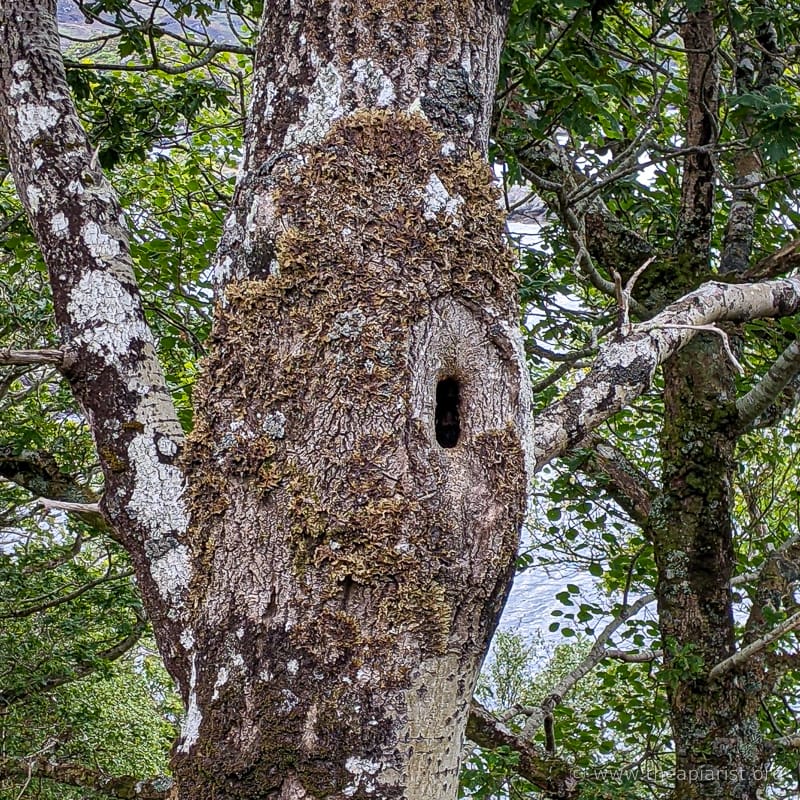
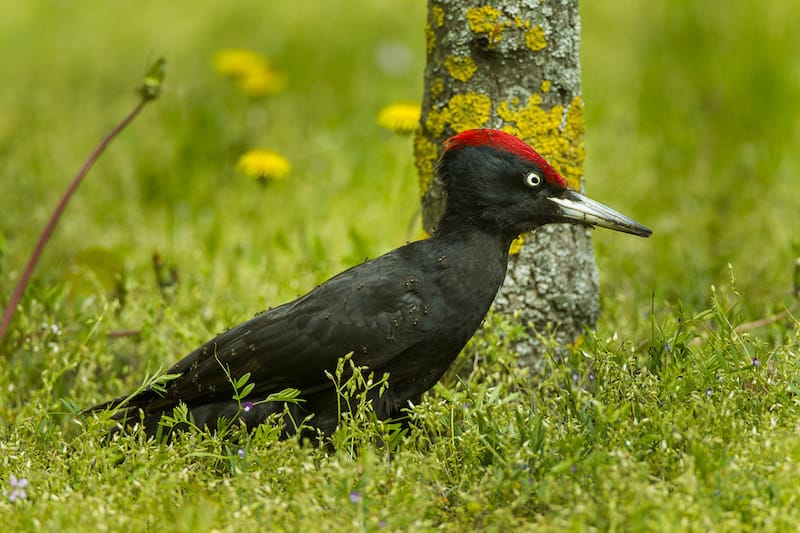
Join the discussion ...